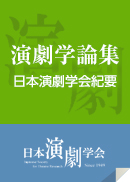Volume 67
Displaying 1-13 of 13 articles from this issue
- |<
- <
- 1
- >
- >|
-
2019 Volume 67 Pages M1-M3
Published: March 15, 2019
Released on J-STAGE: March 20, 2019
Download PDF (159K)
Papers on the speial issue “Postdramatic Theatre”
-
2019 Volume 67 Pages 1-8
Published: March 15, 2019
Released on J-STAGE: March 20, 2019
Download PDF (371K)
Research Articles
-
2019 Volume 67 Pages 9-29
Published: March 15, 2019
Released on J-STAGE: March 20, 2019
Download PDF (618K) -
2019 Volume 67 Pages 31-54
Published: March 15, 2019
Released on J-STAGE: March 20, 2019
Download PDF (613K) -
2019 Volume 67 Pages 55-70
Published: March 15, 2019
Released on J-STAGE: March 20, 2019
Download PDF (430K) -
2019 Volume 67 Pages 71-88
Published: March 15, 2019
Released on J-STAGE: March 20, 2019
Download PDF (698K) -
2019 Volume 67 Pages 89-107
Published: March 15, 2019
Released on J-STAGE: March 20, 2019
Download PDF (474K)
General paper
Research Articles
-
2019 Volume 67 Pages 109-128
Published: March 15, 2019
Released on J-STAGE: March 20, 2019
Download PDF (506K) -
2019 Volume 67 Pages 129-148
Published: March 15, 2019
Released on J-STAGE: March 20, 2019
Download PDF (647K) -
2019 Volume 67 Pages 149-165
Published: March 15, 2019
Released on J-STAGE: March 20, 2019
Download PDF (705K)
Book Reviews
-
2019 Volume 67 Pages 207-213
Published: March 15, 2019
Released on J-STAGE: March 20, 2019
Download PDF (335K) -
2019 Volume 67 Pages 214-220
Published: March 15, 2019
Released on J-STAGE: March 20, 2019
Download PDF (361K)
-
2019 Volume 67 Pages 230-231
Published: March 15, 2019
Released on J-STAGE: March 20, 2019
Download PDF (265K)
- |<
- <
- 1
- >
- >|
